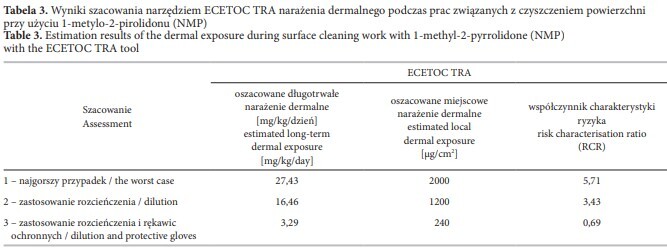Online first
Current issue
Archive
Most cited in 2024
About the Journal
Editorial Office
Editorial Board
Copyright and self-archiving policy
Information clause on the processing of personal data
Declaration of accessibility
Instructions for Authors
Instructions for Reviewers
Contact
Reviewers
2024
2023
2022
2020
2021
2019
2018
2017
2016
2015
2014
2013
Editing and translations
ORIGINAL PAPER
Assessment of the suitability of selected non-measuring models for dermal exposure estimation for the purposes of assessing compliance of working conditions with restrictions 71 and 76 in Annex XVII of the REACH regulation
1
Instytut Medycyny Pracy im. prof. dra med. Jerzego Nofera / Nofer Institute of Occupational Medicine, Łódź, Poland (Zakład Bezpieczeństwa Chemicznego / Department of Chemical Safety)
Online publication date: 2023-12-22
Corresponding author
Agnieszka Klimecka
Instytut Medycyny Pracy im. prof. dra med. Jerzego Nofera, Zakład Bezpieczeństwa Chemicznego, ul. św. Teresy 8, 91-348 Łódź
Instytut Medycyny Pracy im. prof. dra med. Jerzego Nofera, Zakład Bezpieczeństwa Chemicznego, ul. św. Teresy 8, 91-348 Łódź
Med Pr Work Health Saf. 2023;74(6):487-500
KEYWORDS
TOPICS
ABSTRACT
Background: Occupational exposure to chemicals occurs mainly through inhalation and the skin. The inhalation exposure assessment is regulated by law, while in Poland the method of conducting measurements for dermal exposure has not been indicated in the law. However, due to the restrictions 71 and 76 from Annex XVII of REACH for 1-methyl-2-pyrrolidone (NMP) and N,N-dimethylformamide (DMF), exposure assessment by the dermal route is necessary. These restrictions require to ensure that exposure of workers is below the derived no-effect levels (DNELs) for dermal exposure. The aim of the work was assessment of suitability of selected non-measurement forecasting models for the estimation of dermal occupational exposure to chemicals for the purposes of assessing compliance of working conditions with the restrictions 71 and 76 of the REACH regulation. Material and Methods: Three tools estimating
dermal exposure, recommended by European Chemical Agency (ECHA), were selected: ECETOC TRA, RISKOFDERM and
IH SkinPerm, which were used to estimate 2 exemplary workplaces. Results: Results of the estimations of dermal exposure showed
that non-measuring models are useful for fulfilling the obligations under restrictions 71 and 76 of Annex XVII of REACH. The type
of exposure scenario and amount of data available for the workplace are crucial for the selection of the model. The ECETOC TRA was
considered the best model for this type of analysis, whose main advantages are direct comparison of the output data in mg/kg/day
with the DNEL value and use of standardized descriptors system. Conclusions: Exposure modeling is a good and cheap way to determine
the dermal exposure magnitude at workplaces, also to comply with the requirements of restrictions 71 and 76 of Annex XVII
of REACH. The application of modeling in the case of occupational exposure by the dermal route is one of the solutions when it is
necessary to comply with the DNEL for dermal exposure. Med Pr Work Health Saf. 2023;74(6):487–500.
We process personal data collected when visiting the website. The function of obtaining information about users and their behavior is carried out by voluntarily entered information in forms and saving cookies in end devices. Data, including cookies, are used to provide services, improve the user experience and to analyze the traffic in accordance with the Privacy policy. Data are also collected and processed by Google Analytics tool (more).
You can change cookies settings in your browser. Restricted use of cookies in the browser configuration may affect some functionalities of the website.
You can change cookies settings in your browser. Restricted use of cookies in the browser configuration may affect some functionalities of the website.






